I make games and interactive fiction sometimes. More often probably on twitter.
Don't wanna be here? Send us removal request.
Text
The Kidnapping of Princess Pri
resurrecting this with a recent release: The Kidnapping of Princess Pri
The general idea is that Pri is a princess who gets kidnapped all the damn time. She's also blamed for her abductions fairly often by her addled father and her exasperated bodyguard, and it turns out that after a dozen kidnappings, a princess simply must fight back. Even if it means fighting fire with fire. This is the story of Princess Pri. (house exploration/escape game, ~1hr) (first half Liberty, second half psy)


...hopefully will get back into the habbit of rambling/reviewing later.
2 notes
·
View notes
Photo

Not dead somehow, and still making games?? Anyway, got a new contribution to a horror anthology out. Lots of good stuff. Mine's the chapter with the radio: https://rpgmaker.net/games/10123/
0 notes
Text
Fear and Hunger review
a horror rpg/roguelike by orange-, demo available at https://rpgmaker.net/games/9476/
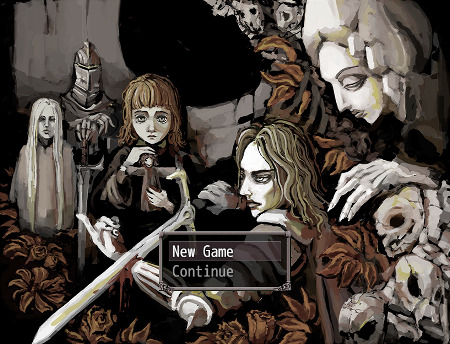
a review
Fear & Hunger bills itself as a rogue with horror and RPG elements, although the only thing roguelike about it really is an inability to save. The player controls the nameable protagonist "Mercenary" while attempting to survive the Dungeons of Fear & Hunger. The only narrative is the one supplied by the player -- the game's heavy on atmosphere, not plot.
This is a review of the teaser demo, which features four levels and about half the planned cast. The scope of the full game looks to be a lot bigger (five playable characters for one thing) but there's a decent amount of content here, maybe one to three hours. I played to the end of the maps, I believe, but probably missed some other content. The review is mostly spoiler free but I'd probably skip the last section.
Aesthetics

While visuals might be the first immediate draw of Fear & Hunger, the sounds is what jumps out first in the game itself. The intro has some really well-fitting music, and simple as it is, it sets the tone for the rest of the game. The background music might not be custom for the game but it sure is employed well. There's a lot of sfx, and as it turns out, just something like low chanting or drip ambiance can be as effective if not more than bgm.
As for the visuals themselves - the painting and pixels work together really nicely, with a unique pixel style I can't quite put my finger on. The special effects on the maps (dim lighting, fog, torches) all complement it well. With at least four distinctive settings, it's always rewarding to get to the next zone just to look at it. It's a compelling reason to keep pressing forward. The map layout itself has a neat feeling where the Dungeons of Fear and Hunger feel less like a series of interconnected maps and more of one big environment -- rooms link together vertically in many places, around curves, or at diagonals allowed with the painted environments. Not your blocky RM game.
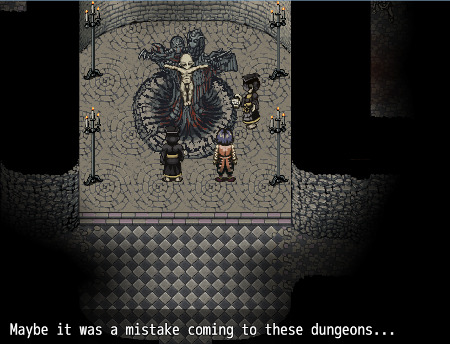
The subject matter is a bit of a different bag. While pixeldick isn't exactly something novel in "dark" RM games, F&H includes multiple explicit sexual scenes, a mountain of corpses and guts, and sprites for the playable characters in various states of armlessness. The standouts are probably the interior of a toilet hole and a twenty person orgy, located about thirty seconds away from each other. I've played other games that have gone for this sort of thing as shock value (and yeah, there's some shocking stuff) but usually there are standout elements that come across as "this was done to be edgy" that break immersion. F&H feels like a coherent whole, if a coherent whole that I would want to stay far, far away from.
Gameplay
I mentioned there was a really appealing intro. I was less enthusiastic around the 20th time I saw it. My experience in my first game was to take a few moments to come up with a fitting character name (important in jRPGs and RLs alike!), wandered inside the first room, scavenged a pinecone, then got killed by a on-touch encounter with a prison guard. Then I watched the intro again. Next time I didn't spend so much time on a character name.
Expect to die in F&H. "Unforgiving" would be one way to put it, but this implies the player has to make a mistake to die. Let me break down the combat system: F&H advertises a "strategic" dismemberment system, where the player aims at a body part with each attack. I attacked the prison guard's right arm at first, destroying it. Then the guard's so-called stinger began pulsing, so I attacked it, destroying it. Then the guard approached too close, clinched, and instakilled me. This is how guards work -- kill them in two turns or face the prospect of immediate death. While I eventually figured out that attacking the head usually kills the guard (at the cost of one of my own limbs) there's still a 33% or so that in any fight with a guard I'd miss an attack or two and end up dead. The combat is more akin to a survival horror in that fights should be avoided because resources are limited. And with extremely limited resources, expect to live for two to four encounters... And it's not like they can be run away from either.

I play a /lot/ of roguelikes, so I want to expand on some of key shortcomings of F&H versus pretty much any modern RL. One core principle is that death is always the fault of the player. With an accuracy that feels around 60%, this is iffy to say the least. Not to mention the non-combat deaths. F&H is one of those games that likes to drop the player into unwinnable scenarios. "Climb into the toilet hole? Y/N? Oops can't get out." That one is probably my fault, but it's the equivalent of getting oneshot by an out-of-sight enemy. While it's technically avoidable, it has an unfair aftertaste.
Keep in mind F&H does not allow saving. This means every time The Mercenary misses a guard twice, it's time to watch the intro again, play through the same early game again (potentially getting unlucky and losing to the first encounter, again) and spend another ten to twenty minutes playing through an area of the game that rapidly loses its novelty. In a roguelike, after losing a character, the player is free to pick a different class, explore a different area, etc. In F&H, there is no redeeming grace here. Playthroughs are virtually identical. Loot is randomized, but this is actually counterproductive -- it's very possible to not spawn an early key to recruit the second party member (The Girl) or find any helpful items at all (maybe 80% I could find no use for). Enemies are vaguely randomized, but this is also annoying -- I would sometimes just restart the game if there were too many guards in the first area.
The way this adds up is that death turns into an annoying time penalty. Having this punishment for every action induces a sort of paranoia that negatively affects the game's core loop. Most RPGs have an explore vs exploit metamechanic built in -- once I've found an effective strategy, how likely am I to keep using a strategy I know works vs keep searching for a strategy that works better? F&H skews this. If I'm paranoid about combat, I will never aim for anything but the head, because I know this wins me the fight 75% of the time, so I'll never explore the depths of any limb targeting system. If talking to NPCs triggers a fight 30% of the time and that fight could cost me 20 minutes, I will never talk to NPCs. I'll never take a yes/no decision to touch some viscera (spoiler: unwinnable fight). After I found talking to prison guards and priests just gave them an extra turn to attack me, I never explored talking to any further in-combat NPCs because the cost of failure is just too extreme. F&H heavily penalizes exploration and favors exploitation.

Overall, the gameplay just feels arbitrary. If there's a strategy to the fights, I wasn't afforded the freedom to discover it (too afraid of dying and watching the unskippable intro again). The stealth system doesn't add much as enemies spot the player from out of sight, and I only managed to once or twice escape after being spotted. To drive this point home, F&H even features a visual onscreen coinflip. Call it right, and find critical loot, evade the guard, etc. Call it wrong, and find squantus, get oneshot by the guard, etc.
Themes
"Theme" seems like something dumb to call this section, like trying to look for the "moral," but the way the game is marketed doesn't shy away from posing moral questions. The gamepage seems to present at least two. First, the question of what is or is not suitable to depict in a game. It sounds pretty edgelordy, but I didn't get much of this feeling in the game itself, and was pleasantly surprised.
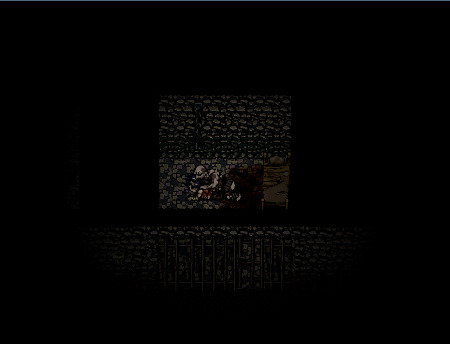
There was also another question presented -- what is or is not acceptable to do to survive? This is a little more interesting but almost self-defeating within the first few minutes of the game, by two elements. First, the prison guards that try to actively murder the player. Killing them is a matter of self-defense, not morality. Second, without any exposition, it appears that The Mercenary voluntarily arrived at the Dungeons of Fear Hunger. Combined with lore admonishing the player to "turn back now" and so on, it seems like a choice to continue exploring the dungeons. There is no escape or survival element, instead, the dungeons feel like a tribulation. What am I trying to prove by putting myself through this hell?
There was only one time I actually stopped to consider the implication of any in-game decision. At a certain point in the game, the player finds a magic circle. With the second character, The Girl, in tow, the player is asked to perform an "act of sacrifice" or an "act of love" to obtain favors from the old gods, or walk away with the girl unharmed.
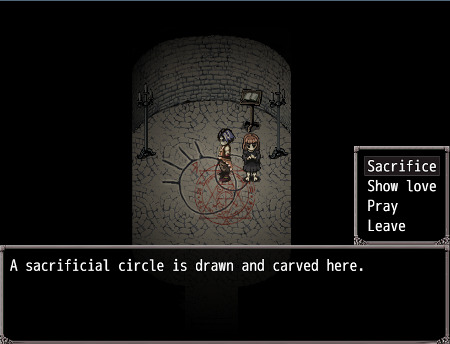
The first time at this choice, I did nothing. Fine. I'll try to win without killing/raping people I rescue from a cage, thanks. Then I died to a prison guard and figured I needed an edge in combat to get anywhere and this was going to be one of "those" games where power comes at the cost of moral taint. Okay, fine. I sacrificed the girl. The screen went dark, she's beheaded, and Gro-Goroth granted me a virtual ohko-ing "Hurt" skill. After depleting my MP using Hurt once and then dying, twenty minutes later, I found the magic circle again, and casually chose the second option, "act of love." After a confirmation, the message simply said "No." And I was presented with game over.
That's probably the moment that's stuck with me the most after playing through the game maybe a week before writing this review. I couldn't get why the game would reward the player for killing her but punish the player for attempting sex with her. At first I thought F&H must have some inbuilt if questionable moral system -- they're both abhorrent acts, but F&H only wants to encourage a certain kind of abhorrentness. I did go back and question what exactly made me think it was permissible to take that second option, and it's probably the old explore/exploit question -- the skill from option #1 wasn't actually that great, so I chose option #2 in the sense of "I went left last time, this time I'll go right." Replaying the game so many times and freeing the girl from the cage so many times did a lot to cheapen her life. When I initially sacrified her, my thinking was that if this was the wrong decision, who cares, she'll be back in that cage in about five minutes when something else in turn murders me. That self reflection was probably the deepest thinking I got in this game, but it did stick.
But then after reexamining the gameplay, it became clear to me that outside of my reasoning behind making this decision, this whole sacrifice setup was just another cointoss. In F&H, punishment and reward are arbitrary, and life and death are arbitrary. Hell, the courtyard level consists of hanged men in one map and then an orgy in the next. What did the hanged men do differently from the revelers? There are bestial prison guards and ghoulish prisoners, but without context, no reason those roles couldn't be reversed. Maybe they failed a coinflip somewhere.
Moving forward...
F&H is just a demo, but at the moment it's hard to recommend. The game is a unique experience, which makes it a shame that it's so frustrating having to replay the intro so many times to actually access the stuff in the back. I'm sure I missed out on content because I ran out of patience with Level 1 and stopped engaging most NPCs or taking questionable dialog choices.
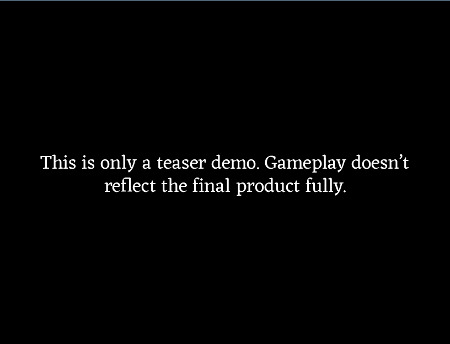
Was the demo successful? Well, it succeeded for me in painting a picture of a foul hellhole where life is capricious and death is up to fate. That's a compelling effect. Except it makes for a frustrating, ungameish game. There's dissonance between this master effect and the gameplay itself, no, but it's just not a good experience. Adding more content would just compound the problem -- adding just one more dungeon level would mean I have to spend twice as long replaying the rest of the game to get there. I haven't put much thought into what would improve the game per se, but it needs something altered in its core loop to make it actually fun and not an exercise. I really hope this game can find a synthesis with gameplay that is less aggravating but still supports its unique effect.
2 notes
·
View notes
Note
Could we suggest games for you to review?
Suggestions much appreciated, always looking for interesting stuff...!
0 notes
Text
Matryona’s Last Night
a dark adventure game by Colonel, translated by HiragiHOUX, English version at https://rpgmaker.net/games/9578/
a review

Okay so what is it?
Matryona's Last Night is a 'dark adventure' game on the label. Basically, it's a short story in game format -- wander around the world, interact with items, view some dialog, advance. It has some horror elements but isn't particularly extreme. Your job as the player is to guide Matryona through the house, search the right items, and learn the truth about "pretty, adorable Matryona." There are two endings, although searching out the "true" ending probably isn't required to get the gist of the game.
Notably, the game is about half an hour, which in my opinion anyway, is a good excuse to play it. However, that also means it's hard to talk about Matryona's Last Night without invoking spoilers because, well, they happen like five minutes in. The second half of this review about the story will be spoiler-y so if in doubt, take the 20-30 minutes and play before reading. The review is short for the same reason.
Aesthetics
The game takes place entirely within Matryona's house, about six maps. There's minimal sound and for the majority of the game no music (a choice I agree with) so the game can at times feel a little bare. Luckily there's some nice insert art to break up the RMVX-style chibi, and it's a nice touch of personality.

When I mentioned Matryona's Last Night to essentially be a short story, I think that holds in its mapping style as well. Mostly everything searchable, and you'll end up searching mostly everything, but it's just a vehicle to move the story. The maps aren't much to look at and don't have much of a distinctive style. It's nothing offensive, and mapping isn't exactly the focus of the game, but because the player will be spending a lot of time just searching stuff, the focus falls there.

Story
SPOILERS remember... Basically, it's a time loop.
When thinking about the narrative of this game, I think it can be separated into two parts: the story itself and the vehicle to deliver it. The story is about Matryona's upbringing as a girl and the murder of Matryona's family by his own hand, and the story structure is a time loop starting with the future first, and gradually looping back to the events of the titular last night.
I'm a sucker for time shenanigans, maybe, but I like the way Matryona's Last Night is told. By working through the story non-linearly, there's room for the player to piece together what happened (I guessed pretty much everything ten minutes in) and even once you realize what's going, there's still at least some tension -- Matryona is doomed to commit murder, whether you as the player know it's coming or not, and that loss-of-control inevitability can be compelling. Execution-wise, it felt drawn out (even when it's obvious what's going on, Matryona has a few monologues to dead people that don't do much). Still, it's an engaging way to tell the story and I think it's effective, even if the actual story content is predictable and causes the format to lose a bit of its power.

^ the problem, better than I could phrase it
As for the story itself... It's a gender issue, which I'm mostly unqualified to respond to critically but will try anyway. Matryona is male, identifies as male, but his mother forces him to identify as female, running the gamut from dresses to makeup to the girls' uniform at school. Matryona obviously resents this, which leads to murder once Sasha, a "real" girl, shows up.
While the scenario allows for a (telegraphed) "twist" that Matryona is a boy, because of where the choices fall, it's not meaningful. Matryona has no conflict about gender identity, and even in a flashback to Matryona's birth, it's never clear exactly what motivates his mother to raise him as a girl. The story can be simplified to "Matryona's parents wrong Matryona" -> "Matryona takes revenge" and that negates the entire gender question completely. The meat of the conflict doesn't have an impact on the part of the story the player witnesses, which makes it feel like Matryona's Last Night just doesn't have a lot to say. There's a clear villain to blame (Matryona's mother) and her actions come off as arbitrary cruelty. The question of whether Matryona's actions are justified isn't a major theme, and because Matryona has no inner conflict himself, there's no real statement to be made here.
Verdict
Matryona's Last Night is basically a narrative experiment. Is it interesting to investigate the same scene three times in a row, moving backwards to figure out the truth? Yes. Is the actual linearized plot of the game meaningful? I don't think so, anyway. I'd like to see more non-linear storytelling in RM games, although maybe with stories that had more impact in their core twist. At least it's short.
To the translation team -- much thanks for your work on this project. It seems to be the kind of low-hanging fruit worth bringing to English audiences.
0 notes
Text
.defrag
a surreal experimental adventure game by ForgottenDawn (https://rpgmaker.net/games/9142/)
a review

defrag what?
.defrag is a minimalist/surrealist game, drawing some influence from Yume Nikki and its ilk (.flow) while having a more concrete storyline. (Once again, a disclaimer, I still haven't gotten around to playing Yume Nikki so my perspective could be lopsided. Either way, it's got a stark, black/white/noise feel and soundtrack to match. The project is near completion, with just a few polish items missing, and total playtime is somewhere at 3-4 hours.
This review should be mostly spoiler-free, covering the 1.3 preview release.
Story
The player character of .defrag is a humanoid figure, nameless and mute. While some friendly computer monitors give you some hints at the story as you're birthed into the world of noise, there's very little background and the world of .defrag exists mostly outside of any reality, sort of a standalone universe. Your character's lack of identify cements this.

I was a little worried in the first zone - The Aether. With a literally faceless protagonist, randomy "noisy" environment, and no clear goal in sight, I wandered around a little bit, then luckily found my way out. The rest of the game is roughly broken into zones, each with some memorable characters, multiple lines of dialog, and visually distinct designs. At this point, the game is open-ended. I personally wandered around, talked to everyone in sight (once), and started to piece together the premise of .defrag: the world is under assault by a "noise virus" with varied and unclear effects.

.defrag is a pure walking simulator, in that the only gameplay is traversing the world and talking to its residents. Luckily, the residents are a diverse set of folks. The character design is fun. Most of the everyday NPCs have their own consistent personality, and while the writing's never laugh-out-loud funny, it's enough to keep the player interested. The areas without NPCs are definitely less engaging. The major characters (mostly the aptly-named Blob and JIM THE GOD OF DEATH AND DESTRUCTION) have multiple expressions too, which adds a lot. The other major character is unseen, and your only form of contact with this mystery person is a series of signs which slowly grow from informative ("Junkyard ->") to narrative ("If I see one more turn, I swear to god...)
Eventually, once exploration is over, there's a series of not overly noteable fetchquests, but the game ends up turning linear. New areas (the Radio Tower, Purge Hospital) open up, there are some plot twists, and eventually a very thrilling buildup and finish where the game takes on some horror elements. The pivotal "loss of control" moment happens around Purge Hospital, where .defrag switches from open world to closed world, the pacing kicks up a notch, and the game turns genuinely unsettling. It's a very tight and well-executed second half.
Pacing
...and then, there's a whole other half of the game? This is probably the weirdest part of .defrag and its biggest flaw, in my opinion anyway. For reference, here's a graph of my interest in the game as time progresses, roughly to scale over the four hours I played:

Notice that big flat portion after the climax? After the player visits every area, after the big mystery of .defrag is solved, after every character shows their true colors... then a whole new set of characters show up? There's two new sets of quests? And none of these quests actually expand on the world of .defrag or its mystery. While the new characters are all as fun as those in the first half of the game, they're simply irrelevant. The thrill is gone (there's no plot past this point, let alone plot twists) and the exploration is gone (no new maps, either). What's left? Character interaction, which is enjoyable enough, it's just not enough to make this part interesting. The second half of the game is empty content.
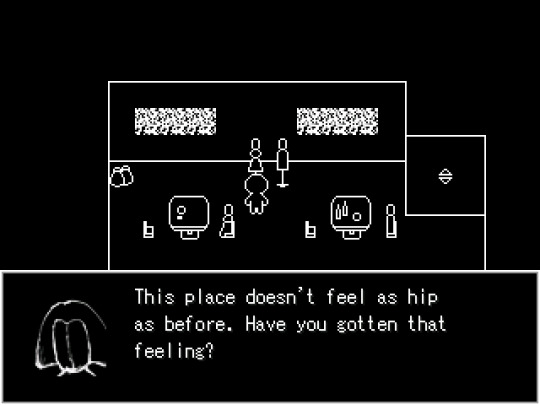
Some of this is compounded by the mechanics .defrag uses to move the player from one plot point to the next. Most of the gameplay is "character A requests you to talk to character B," followed inevitably by "character B requests you to talk to character A." The other half of the gameplay is "character A talks vaguely about character B," after which the player is supposed to psychically determine that new dialog options have opened with Character B. Just because Bill mentions Blob, I'm supposed to know to talk to Blob again? This is the cause of the "wandering" segments on most of my graph -- new options had opened somewhere but I didn't know the where. This is compounded by the open-worldness of .defrag -- it's possible to explore places before the fetchquest series requires it. For instance, I was told to find The Hub... immediately after previously talking to every Hub denizen.
Luckily, there are mitigating factors. Towards the endgame, characters offer to warp you to your destination. More importantly, there's a Speed Hax item that ups the walk speed, so retraversing areas isn't all that painful. I definitely would've quit without this item. It's a godsend from the developer and plenty of other games could take the hint. There's also a fast transport system to warp from one zone to another but for whatever reason, this system only unlocks in the second half, when there's no longer a reason to revisit zones. It's a pointless reward at that stage in the game.
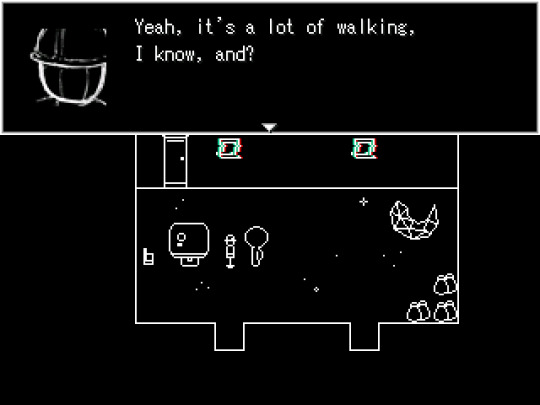
All that said, as soon as the player reaches the Radio Tower, there's about an hour where everything is purposeful, well-paced, and well-executed. It's ironically the most restrictive part of .defrag, but this game is so much better when you know your purpose rather than backtracking through zones looking for one.
Aesthetics
The first thing that jumps out about .defrag is that it's monochrome for the most part, and it has sort of a glitchy aesthetic, etc, which is all fine and I enjoyed the game's visuals mostly. But seriously, the most striking thing about this game is its amazing sound design. The BGM is 80% noise, 20% conventional soundtrack. The noise parts vary from inoffensive to oppressive and powerful. Radio Tower especially is about three times more intimidating than it has any right to be thanks to its sound. While it's not much to listen to on its own, playing .defrag without the sound on would be a huge mistake.
https://forgottendawn.bandcamp.com/track/the-radio-tower https://forgottendawn.bandcamp.com/track/the-reveal-part-i
(Some of my favorites, free listening at Bandcamp)
(oh and for what it's worth, the part of Yume Nikki I'm most familiar with is its OST and I'd say .defrag is a worthy rival)
The conventional pieces only show up around the climax, and while once again, they sound average removed from the context of the game, they work fantastically well where they're positioned. The final areas start to layer ambient melodic components on top of the noise, and then finally there's true affecting, orchestral pieces for the climax. It's a powerful constrast. Combine this with the minor SFX throughout the game (footsteps, doors, hospital ambiance) and I can safely say .defrag's biggest asset is its sound.
Back to the visuals -- they work. The mapping is fine and varied between zones. Some areas are prettier than others. I especially enjoyed the wireframe sculptures of The Garden and the futuristic feel of The Hub. The glitchier areas of the game (The Aether, The Plant) weren't as fun, and some were uninteresting due to level design more than visuals, for instance, the hold-the-left-arrow-key Junkyard or infinitely-looping cellar areas outside The Hub.

As mentioned before, the character visuals are spot on though. I only wish more characters were present in the first half of the game, because in the first half, apart from the wireframe NPCs, expect the only faces to be Blob and Jim. Luckily Blob is very... expressive.
In conclusion...
.defrag is fascinating and for the most part, fun. The half a game that comes after .defrag is superfluous not fun. While there are a few mixups caused by the exploration elements in the first half, it's ultimately a unique and engaging experience. What I'd want from a .defrag 2.0 is its postgame content tucked into its first half. Most of the problems in the first half are what-do-I-do where-do-I-go problems that probably can't be solved without killing the fun that is exploring the world on your own, but more content there would definitely cut down on the "Wandering..." moments. The second half can be cut entirely and I'd recommend anyone looking to play .defrag (you should), just quit after leaving Purge Hospital. It's a quirk of the game that it can be "ended" at any time after the climax, so consider the rest very (VERY) optional.
In fact, there's one exact moment I can pin down as what feels like the "real" conclusion to .defrag. It's a scene in the hospital just after the climax where the player finally learns the fate of their predecessor, the person who placed all those signs around the world. If the low points of .defrag are backtracking through environments looking for someone whose dialog changed, then this is the high point: haunting use of sound, a well-told story, a discovery, and an emotional kicker. Play this for the good stuff.
2 notes
·
View notes
Text
Project 4
a horror/independent adventure game by lizardotaku (https://rpgmaker.net/games/9461/)
a review
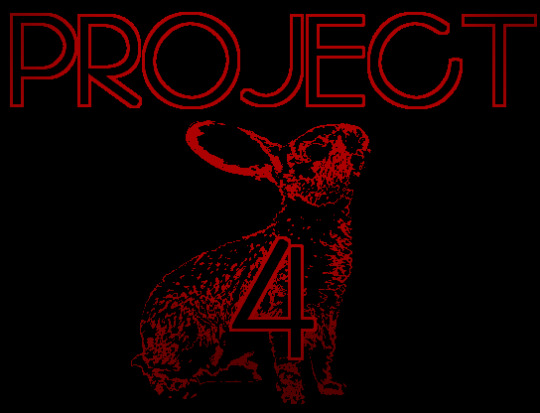
So what is it?
Project4 is advertised as a a horror/adventure game, and it definitely leads towards the adventure side with a heavy dose of surrealism. It's inspired by the likes of HOME and OFF, neither of which I've played, so my perspective might be a little odd... especially considering I don't play many horror games to begin with. However! I do like "walking simulator" games so let's see what Project 4 has to offer. It's advertised as "shortish" (~2 hours) and "complete" which are both things I appreciate.
I'll try to make this spoiler-free.
Story
Project 4 opens with an intro story about a pair of twins who live isolated in a forest, surrounded by other children hunting rabbits. When the player takes control of Trost (Class: Actor) in a completely unrelated environment, my impression was that Project 4 is ruled by two different stories: a concrete one outside the game's environment, and a central conceit/metaphor story of the projects. The "real" story is updated as Trost progresses through each of the projects. Trost has an objective, and is oppposed to the projects and their worker denizens, etc. As the game continues, the story is wrapped up in the named engineer minions that populate the projects, but especially mystery characters like Emil that show up in each zone to support Trost. The relationships between the individual project managers (bosses, basically) are all interesting as well, especially the last two, Tris and Dell, which are unusual fights where Trost is the agressor. Each zone has a self-contained plot that plays out as Trost visits (and generally kills off half the project's residents), plus things like notes/logs that tie together a story between all of the projects, their former visitors, and dynamics between each of the project heads.

Then, after the last fight of Project 4, after Trost's rampage is finished, the concrete story from the beginning picks up where it left off to end the game. Confession time: I didn't fully get it. I spent a decent amount of time trying to understand how the narratives fit together (the conceit/metaphorical one inside the projects vs the one outside) but I couldn't parse the pieces. I could piece together who the characters were in the projects vs the characters in the conceit, but but by the end of the game, this wasn't new info. I felt like they're should've been a payoff at the finale, some sort of "Ah-ha!" revelatory moment where the meaning of the projects and the characters would take on a new light, but it just never came, even after I spent some time trying to refigure it out, including replaying the first half of the game or so.
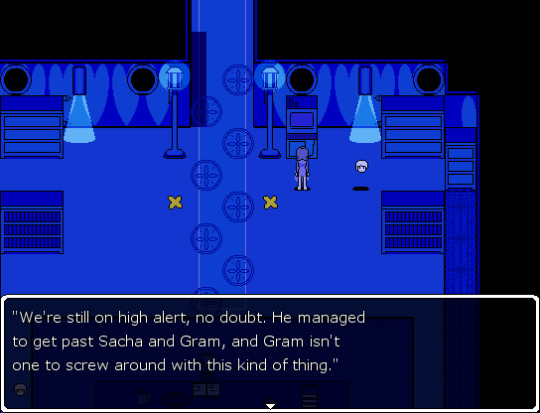
My conclusion is that the timeline of the external, real story of Project 4 is wobbly and not really a linear narrative... more of a "master effect" feeling kind of thing. That's my biggest gripe with this game: the way the twins' story cuts into the projects' story heavily imply there's something crisp to be figured out, but really it's much muddier. Stuff I didn't understand includes an entire playable character "Blackmail" who shows up out of nowhere, the fate of Emil, the purpose of the big ghosty chase scene character, and generally what the linear timeline is to the story of Project 4. When for 90% of the game I think there's a deeper meaning to look for, and then in the closing minute, the meaning is just as vague or inscrutable as everything else... The rest of the story retroactively loses its impact.
Aesthetic
In short: it's good. My initial interest in this game was almost solely from its title screen. It reminded me a ton of an animated short titled "Rabbit" I remember from a ways back . Either way, the game doesn't quite pan out like that. Black and red aren't the themes here, more "vivid color" on black, and strong tonal contrast in general.

I'm not sure how much of this is an idea from the inspiration sources of Project 4 (HOME/OFF) but it's executed really well. The four titual projects each have their own color theme, emotion, guardian boss, NPC attitude, etc. The first project feels a little empty (the only events for the first few maps are stream traps), but by the time I got to Project 4, I was really into it. The intro to Project 4 is the high point of the game -- there's a neat panning and title drop for each, and the one for Project 4 capture this rainy, melancholy feeling much better than I can put into words. It's super nice.
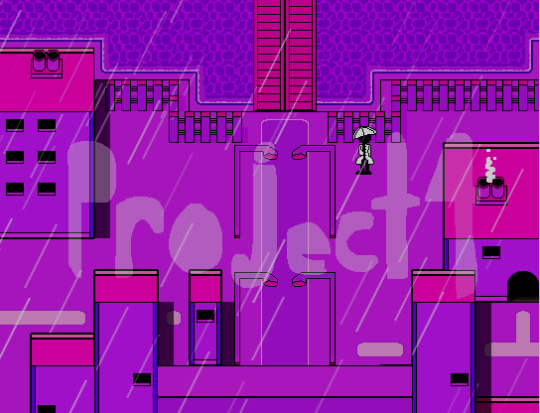
The tiles all fit in with the themes -- they're straightforward and sometimes evocative. The tiny animations are very welcome, they make the game feel alive and they're subtle enough to be atmospheric without attracting too much expression. Facesets are also simple and effective, and the colors all match the project, a nice touch. I can't stress how much individual expressions helps convey the characters. Emil especially has an amazing faceset. The battle actors are (mostly) great as well. There are a lot of variants on the individual enemies, and towards the middle of the game, they start trending surrealistic. I definitely like the "strange" vibe vs the traditionally horror ones encountered in the second half of the game.

Speaking of surrealism vs horror, the few places where the game fails to live up to that title screen are when it tries to be a straightup horror game. There's an incongruous chase scene around midway that's not interesting, scary, or fun from a gameplay sense. The same character comes back later on and I still don't really get it. The disclaimered gore/language in Project 4 is alright -- it serves as a nice contrast with the environments anyway -- but it doesn't stand out too much.
Sound is a mixed bag. The menu stuff is generic enough except for the dialog scroll tick (nice). Music is from a variety of free sources and generally used well, although I don't like recognizing tracks in game from other places (such as with the Presence of Music) but it's alright. I winced everytime I heard scream.wav though.
Mechanics
Combat is not this game's strong suit. I've never, ever seen a single-character combat system work well in an RM game, or even an RPG, outside of roguelikes. And Project 4 is single character for the vast majority of the game. Worse, there's a single dominant strategy: spam the "PARALYZE ENEMY" skill. It locks down the enemy for a solid 2-3 turns, by which it's easy to paralyze other enemies on screen as well. It trivializes the boss fights too, as everyone is equally vulnerable. It also seems an odd design decision to have skills cost no MP - that would've put a limit on my paralysis spam, at least, although having no skill cost basically meant I was using an ability every turn rather than mashing the attack button like most RM games. At least there are no random encounters and the fights are relatively quick -- I didn't get bored.
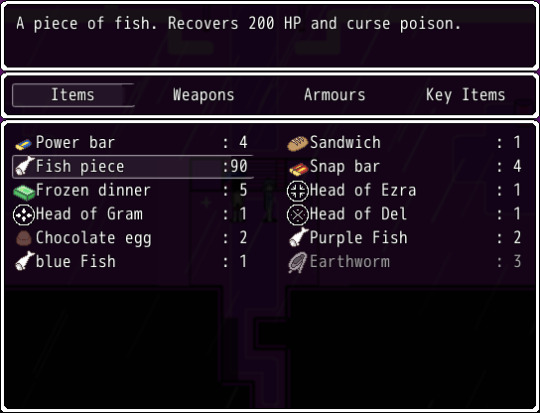
There are a ton of items to be picked off the ground, mostly restoratives, and a character that sells healing items as well. None of these are relevant, of course, because paralyzed enemies do no damage, but even if they were, an issue: One of the items for sale costs 1 gpmoney. So I bought a hundred Fish Piece items at the first shop, thinking I was clever for finding an infinite healing exploit, aaand then never touched my fish stick stack for the rest of the game. Oh well.
Apart from combat, there's the one previously-mentioned chase scene (I had to restart three times but the solution is "hold the down arrow key") and a fishing minigame. I was pretty amused by having the game tell me the height and the weight of the keys I fished out of the sewer but I didn't exactly get why this game has fishing in the first place.

There are a few puzzles and timed maze sort of challenges, most of which are passable. I didn't appreciate a screenshaky one in Project 4 where I couldn't tell where the exit was, but the most egregious thing in this game is a "enter the code" type challenge at the end of the game, also in Project 4. It uses the Hero Name Entry system to take a passcode, and if it's incorrect, starts a battle. Okay, to start off the battle is trivial because all combat in Project 4 is trivial, but expect to fight this fight a thousand times because there's no indication that the passcode is a numeric passcode, or indeed any indication at all of how to figure it out. There are numbers in the surrounding room ("There are zero good reasons to trust anyone, not a single one") but they're vague, out of order, and include terms like "several" which apparently means 7. Anyway, even after basically reading instructions for this puzzle on the gamepage, I still had to cheat to figure it out. Just skip this one, seriously.
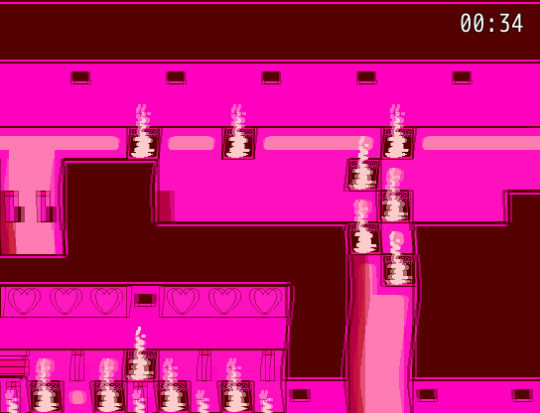
I'm not sure if Project 4 would be improved as a pure "walking simulator," without the combat. The violence is a theme, at least. I wonder if there's a good way to rethink the combat to make the single character fights interesting, but the rest of the gameplay cruft could be safely cut along with the straight horror elements (the chase scene, basically).
Conclusion
Project 4 is an interesting, unique, game. It's short enough where if you're still reading it's probably worth playing (). I only wish I could recommend it more strongly, but the conclusion just lacked the power to make the game memorable. I really did enjoy exploring the world of the projects, the purple Project 4 especially, but the whole thing almost seems like a "cargo cult" exercise in a surrealist game -- it has a lot of well done aesthetic elements there, plus some neat characters and an overall sense of mystery, but because that core story comes off weak, it's not possible to put meaning in any of those things. I can't decide if I want to see this game with a revamped/revised conceit with the story of the twins, or just some of these environments show up in a tighter, punchier game, but either way, I appreciate about half of what's here, even if it's only the nucleus of something that's really great.
1 note
·
View note
Text
SaGa4 update + gameboy palette stuff
Decided to reboot the tumblr because I feel like writing design stuff about the SaGa clone again. Progress is smoothish, probably a release before the end of the year. Until then, I figured I’d write a bit about some of the design decisions and technical tidbits we’ve run into while developing the game, mostly about capturing the Gameboy feel from both a programming and design perspective. So expect a mix of game design theory and obscure SaGa technical details. This update’s a bit old and on RMN but should be another soon.
I’ll start off with some notes around our color scheme (which is coincidentally where I left off on design stuff like a year ago…) Some history first. If you played SaGa on the original bricklike Gameboy, you’ve experienced its original monotone green color scheme.

As you can see, it’s very green and looks a little strange on modern screens. That’s because the original Gameboy LCD screen didn’t have a backlight, and the simulated greeniness looks strange on a monitor. It’s supposed to be more of a black and white feel, which is why modern emulators (for backlit PC screens) usually just render grayscale.

It looks fine, but we can get more authentic than the clean palette even without simulating the original GB greens. On the Gameboy Color and Gameboy Advance (where I played a lot of SaGa), original Gameboy carts would be rendered with a colored palette. Because the original GB carts didn’t provide a palette, just intensity, the GBC would infer a palette. Each of the shades of gray gets mapped to a color.

Interestingly enough, the game now has more than four colors. What’s happening here is that the GBC is treating tiles and sprites differently. The Gameboy rendering pipeline makes a distinction between static maps and moving sprites, so there are actually seven colors here: four shades on the map layer, and then three shades plus transparency on the sprite layer. It’s pretty neat, you could even change the palette by holding different buttons on startup. Full list at https://en.wikipedia.org/wiki/List_of_video_game_console_palettes#Game_Boy_Color
Things were starting to look a little better in SaGa4. Characters were actually brown, water was actually blue (or at least green-blue). But the GBC false color palettes were also not designed for a backlight, so the colors look pretty saturated on a PC monitor. To put together the final palette, we toned down the color scheme a bit until things looked only GBC-ish enough to be mistaken for monochrome.

Not too bad! All of this is done in a shader at a pretty high level so we can still do animated transitions like fade-in fade-out and the shader will enforce the palette. (If you’re curious, full source here: https://github.com/psywombats/mgne/blob/master/saga/res/shaders/gameboy.frag) Of course, the downside is it’s pretty easy to tell what’s on the map layer and what’s actually a sprite.

Hmmm, not suspicious at all.
0 notes
Photo




Experimenting with Gameboy (Color?) palettes. Top two are a monotone and retouched GBC-style one. GBC actually renders GB games with the palette on the bottom left, but because there's no backlight it ends up looking washed out, like bottom right. (supposedly) I was never much into original gameboy greens.
0 notes
Photo




Man's Best Friend (men in hats edition) released! Download and info here Man's Best Friend an exploration-based game following Miles as he tracks down his pet dog Doc. All gameplay is through NPC interaction and solving puzzles in the areas around Waldsberg. Though there is very little story presented at the beginning of the game, there are a variety of subplots to be uncovered that all point toward Doc's whereabouts and his own quest... New version features collectable hats and more morons to talk to. Have fun!
4 notes
·
View notes
Photo

Lunacity http://rpgmaker.net/games/5688/
A first review came on, it received 4 stars out of 5! I am happy for this and I hope people who try this game enjoy it!
8 notes
·
View notes
Photo




So that roguelike-in-a-month I was working on is done, Zephyr Skies: Fall of the Necromancer. It took a turn for the weird at the end so it's a little meta/surreal but oh well, fun enough.
0 notes
Photo

I’d like to also introduce Garibald’s “other self”. His name is… Um “Garibald’s Golem form”. Now play nice!
click the image for full body
6 notes
·
View notes
Photo

I’d like to introduce a new party member. He goes by the name Garibald.
click the image for full body
19 notes
·
View notes
Link
I am a pirate. I’ve always been a pirate. And when I was a young pirate, like all young pirates, I viewed my piracy as justified. It was a startling encounter one day in highschool when I met a person who challenged my inner certainty that there was nothing wrong with piracy.
"It’s just…
31 notes
·
View notes
